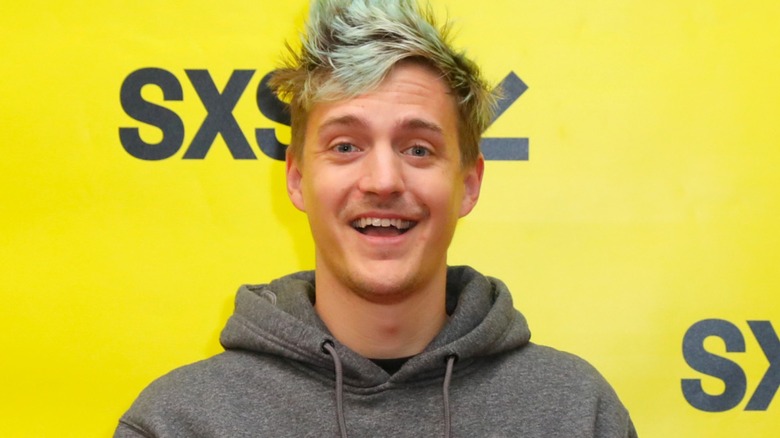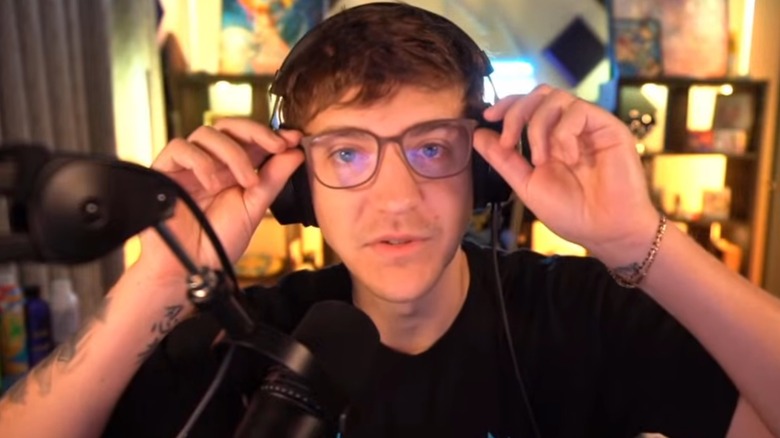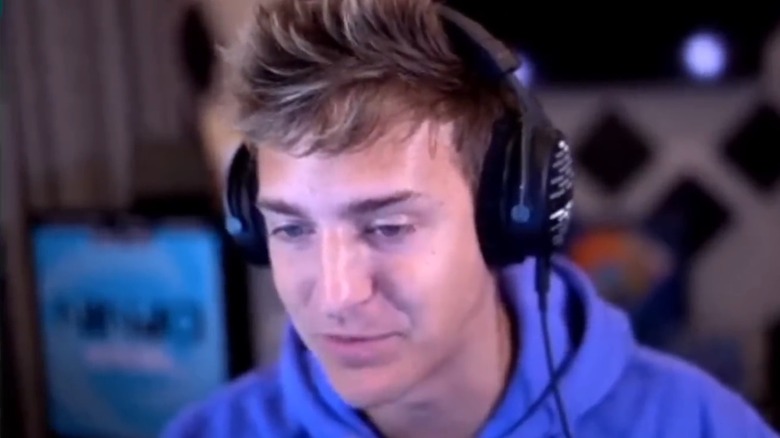It's Clear Why Ninja Has Lost 98% Of His Viewers
If you're at all familiar with Twitch streaming, then you probably know the name Tyler "Ninja" Blevins. Ninja was far from the first Twitch streamer, but he was one of the first streamers to become a mainstream success. Even before all the fame, Ninja was an avid gamer, but he switched to streaming full time in 2017 and never looked back. Before long, thousands of people were showing up on Twitch to watch Ninja play "Fornite." As the game became more and more popular, Ninja's reach grew, and people who showed up for "Fortnite" ended up staying because of his personality.
There's a surprisingly long list of celebrities who stream on Twitch, with everyone from Snoop Dogg and Drake to Alexandria Ocasio-Cortez getting in on the action at one point or another, but it's not very often that streamers become celebrities outside of their own space. For Ninja, streaming was just the beginning. He managed to achieve a level of mainstream success and Ninja even had a bit of a Hollywood career. However, since the height of his fame in 2018, Ninja has lost a whopping 98% of his viewers. So what happened?
What was Ninja's viewership peak?
Before he was a streamer, Ninja was a pro gamer. He started playing "Halo" at a professional level as early as 2009, almost a decade before he ever went live on Twitch. Ninja made a name for himself in the gaming community as a top-notch "Halo" player, winning a number of competitions. He won his first professional tournament in 2012, coming in first place as a member of the team Warriors at the "Halo 4" exhibition at MLG Dallas. He went on to scoop the top prize at AGL 6 Pittsburgh as a member of the G4C Misfits and he came in first once again at AGL 8 Knoxville as a member of Team Requiem.
Ninja's history as a competitive gamer meant that he wasn't completely unknown when he started streaming on Twitch in late 2016. Still, he didn't suddenly become known as a great entertainer overnight. Ninja's Twitch viewership exploded in 2018 thanks in part to the overwhelming popularity of the streamer's go-to game: "Fortnight." He found himself streaming to hundreds and then thousands of viewers every single night. In April 2018, Ninja hosted a live event at the Esports Arena in the Luxor Resort & Casino in Las Vegas, and he shattered Twitch's viewership record at the time. During the event, Ninja's viewership peaked at 667,000 concurrent viewers. In terms of numbers, this was the high-point of Ninja's streaming career.
Ninja streamed more and to fewer people on Mixer
In 2019, not long after his record-shattering livestream, Ninja shocked his community by leaving Twitch. On August 1, Ninja went to social media to announce that he was moving to Mixer, a relatively new streaming platform owned by Microsoft. "I'll be streaming on Mixer full time now. I'm honestly at a loss for words. I'm freaking out in the best way," Ninja said in a follow-up post. He added, "I just feel like I'm going to get back to the streaming roots, and that's what it's all about." Mixer reportedly paid between $20 and $30 million to snatch Ninja at the height of his career.
Ninja wasn't wrong about getting back to the roots of streaming, but he might have forgotten how difficult streaming can be at the beginning. Millions of people showed up to Ninja's first stream on Mixer, and at the time Ninja had more than half the entire platform's audience in his stream. After that, his viewership dropped off sharply, and like a streamer in his early days, Ninja suddenly found himself putting in a ton of time for minimal payoff. On average, Ninja's streams on Mixer were longer than his Twitch streams, but significantly fewer people tuned in. Ninja lost a huge chunk of his viewership when he left Twitch, proving that some streaming fans are apparently platform loyal.
Microsoft closed Mixer in 2020
Mixer specifically sought out Ninja because he was the biggest streaming star in the world, but it turned out that Ninja wasn't popular enough to carry an entire platform. Ninja hit his concurrent viewer peak on Mixer during his debut stream, but it was under 100,000 viewers. That's incredibly far from his Twitch viewer record, and unfortunately things didn't improve from there. Ninja's viewership fell off a cliff after the move, but before he had time to build up his audience, everything changed.
In June 2020, less than a year after Ninja signed his exclusive deal with Mixer, Microsoft shut the platform down. The company pivoted to a partnership with Facebook Gaming, and in the process, it let Ninja out of his exclusive streaming deal. At that point Ninja was free to take his streams back to Twitch or to a new platform like YouTube, but that meant trying to convince his audience to move with him all over again. Some superfans were sure to follow Ninja wherever he went, but just like when he initially moved to Mixer, Ninja was set to lose another chunk of his audience with the new move.
Ninja's Twitch return fell off quickly
Ninja didn't immediately move back to Twitch when Microsoft announced that Mixer would be closing up shop. It took Ninja a few months of deliberation, but on September 10, 2020, he made a video revealing that he was going back to his streaming home. Ninja's fans were absolutely delighted to have him back on Twitch, and the platform welcomed him back with open arms. As reported by ESPN, Twitch senior vice president of content Michael Aragon said in a press release, "We are thrilled Ninja is returning to Twitch ... Gaming — and the people who love it — are being recognized by a broad mainstream audience now in part because of Tyler, and we know he's just getting started."
Ninja's first few streams on Twitch almost made it seem like he'd never been gone. Despite his one-year hiatus from the platform, Ninja's streams were getting nearly as many viewers as they had been in 2019. The buzz about Ninja's return sparked some interest, but that energy didn't last. Before the year was out, Ninja's viewership had fallen off sharply, returning to about where it had been during his time on Mixer. Ninja's streams were often averaging fewer than 20,000 concurrent viewers. Compared to the vast majority of people who stream to almost no one at all, Ninja was still a massive success, but he'd already come a long way down from his peak.
Fortnite isn't helping Ninja anymore
The move from Twitch to Mixer and back again was incredibly profitable for Ninja, but it also irreparably damaged his viewership numbers. As Ninja was flip-flopping between platforms, some of his fans were discovering new streamers. At the same time, one of Ninja's biggest career boosters was starting to help him less and less.
"Fortnite" is Ninja's favorite game, and for years his success seemed to be directly tied to the game's popularity. As more and more people discovered "Fortnite," they started showing up to watch Ninja play it on Twitch. Compared to so many other free-to-play games, "Fortnite" has had a ridiculously long lifespan, but unfortunately for Ninja, no game stays popular forever.
In the 2020s, "Fortnite" started to see its audience fall off. Some divisive "Fortnite" seasonal mechanics have driven players away, and others have simply drifted off to different games. One player that the game hasn't lost, for better or for worse, is Ninja. In 2025 "Fortnite" recorded its lowest player count in two years, and it's not surprising that the game's low point lines up with Ninja losing 98% of his viewers.
Ninja has tried other business ventures
Some of what's happened to Ninja's streaming audience has been completely outside of his control. Ninja took a gamble on Mixer, but he had no way of knowing that Microsoft would give up on the platform so soon after he started streaming there. Ninja also doesn't have any official role with "Fornite," and the game's popularity has very little to do with him. On the other hand, Ninja hasn't been as single-mindedly focused on streaming as he once was, and that might explain some of the numbers here.
Even while Ninja's streaming numbers were falling, his online fame was opening new doors for his career. In 2019 Ninja got to perform for the camera in a brand new way when he made an appearance on "The Masked Singer" belting "Old Town Road" by Lil Nas X. In 2021 he made a cameo in the Ryan Reynold's movie "Free Guy," and since then he's had a handful of vocal cameos in various animated projects.
Ninja also put some of his energy into helping other people find success as streamers. "In this next chapter, I'm going to make it a point to elevate and bring more eyes to underrepresented creators," Ninja said in a press release when he came back to Twitch in 2020 (via ESPN). Since then he's also filmed a "MasterClass" series about streaming. To a certain extent, Ninja's own numbers have fallen because he's already made it, and he isn't grinding for himself the way he used to.
Streaming has more competition than ever
The streaming industry has continued to steadily grow since Ninja's 2018 record-breaking Twitch livestream. When Ninja was making a name for himself, he used his reputation as a competitive gamer to break into the streaming industry. Some of the stars who've risen on Twitch in more recent years have barely been gamers at all.
The Twitch streamers who blew up in 2021, the year following Ninja's return to the platform, were an incredibly diverse bunch. Some, like Adin Ross, were primarily gamers, but others, like Corpse Husband, became known for creating spooky YouTube videos before getting into gaming. There were even some people, like Hasan Piker, who were finding massive success doing political commentary on Twitch. With so many new creators and types of content available, it's no wonder that some of Ninja's fans started branching out.
In 2023 Kai Cenat was Twitch's fastest growing streamer, and in 2024, Sketch dominated the platform. Both creators play games, but that's not necessarily what they're known for. People love watching Kai do pranks and stunts or hang out with his friends on stream. Sketch is known just as much for his collaborations with the NFL and other content creators as for his streaming. Simply put, Twitch today looks nothing like it did in 2018. Ninja's streams, however, are more or less the same as they've always been. That's perfect for his small audience, but the majority of Twitch viewers are looking for something new.
Ninja still has dedicated fans
Ninja has lost 98% of his viewers from his all-time peak on Twitch. Instead of hundreds of thousands, Ninja now often finds himself streaming to fewer than 10,000 people at a time. Ninja is nowhere near the most popular streamer on Twitch anymore, but his current career is still something that most Twitch streamers could only dream about.
Ninja's "small" streams are still unimaginably full compared to most other streams on Twitch. People often spend months or even years with fewer than 10 viewers, and Ninja is often working with just under 10,000. His viewership numbers aren't as attention-getting as they once were, but his consistency is what's really impressive. Rather than the peaks and valleys of his early career, Ninja has had roughly the same viewership for all his streams since returning to Twitch in 2020. That kind of small but loyal following can keep a content creator going for years.
What's also impressive is just how dedicated some of Ninja's biggest fans still are. Ninja's young fans nominated him for a Kids Choice Award in 2024 and 2025, almost a decade out from the peak of his popularity. Ninja was one of the first streaming stars to break into the mainstream, and he's going to be able to hold onto that no matter how low his streaming numbers go.









